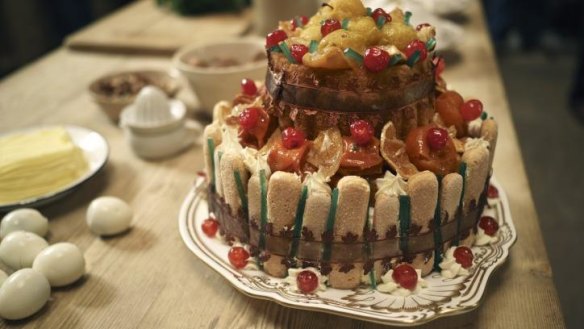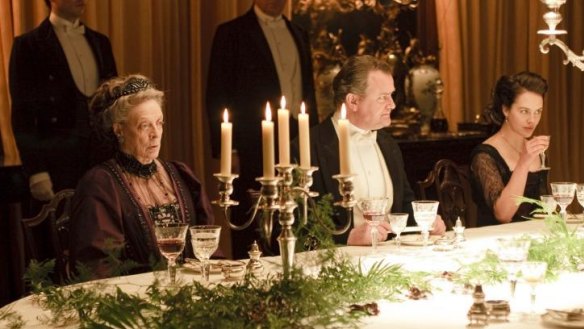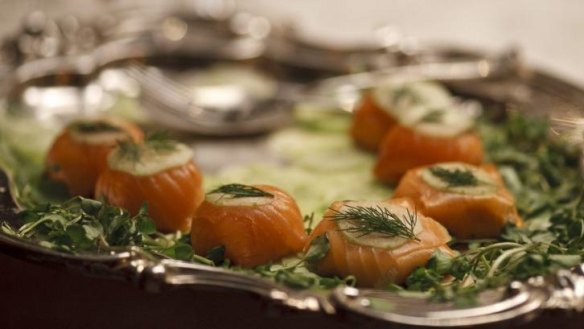Behind the scenes: food styling for Downton Abbey
Food stylist Lisa Heathcote shares what it's like to prepare dishes for the popular period drama series.

Soufflés were on the menu at Downton Abbey, and Lisa Heathcote was standing in a tent in a windy parking lot, making one after another in two makeshift ovens.
"Sometimes they would fall before the director was ready to shoot, sometimes they would fall in the middle of a take," recounted Heathcote, who is Mrs. Patmore, Daisy and the rest of Downton Abbey's kitchen staff rolled into one practical person responsible for all the food on the set.
"The continuity people were freaking out. There were rows of collapsed soufflés, new ones continually coming out of the oven. It was a nightmare!"

As any Downton Abbey fan, knows, that's a lot of food. From the early scene in the first episode, when the Crawley family hear of the sinking of the Titanic over breakfast - thus heralding a new heir for Downton and several seasons of romantic intrigue - to the endless dinners, teas, luncheons (not "lunch," please!) and ceremonial banquets that mark the regular rhythms of aristocratic family life, few television series show more people eating more often.
Nor are they messing about. For breakfast, there might be eggs, sausages, bacon, kidneys, kedgeree (a rice and smoked-fish dish) and toast.
Lunch would be at least two courses; tea would include cake and sandwiches; the evening meal would consist of at least three courses, finishing with a small savoury (like prunes wrapped in bacon), or as many as seven courses if there were guests.

Heathcote has been the food stylist on Downton since the first episode. "We had no idea what it was going to be," she recounted in the kitchen of her house. "A friend had emailed, saying, 'Keep February open, I've got a nice little period drama coming up.' "
That nice little period drama, about an English aristocratic household in the first decades of the 20th century, has now taken over the world, and like everything else that goes into the making of the series, the food, and how it is prepared and served, is precisely planned and monitored for historical veracity.
In her early 50s, Heathcote is blonde, energetic and what the English might call jolly. Drinking coffee and describing her job after a gruelling week of shooting the coming sixth season (she is sworn to secrecy, although it did emerge that marmalade-making is involved), she said that her job was essentially to facilitate what Julian Fellowes, the creator of Downton, required. "He often writes food into the script, and it's always accurate," she said. "But there is a lot that isn't written in that we have to work out in terms of seasonality, what is eaten upstairs and downstairs, and how it will look visually."
Heathcote acquired historical expertise about food while working on films and television series set in bygone eras (The Duchess, Love in a Cold Climate, Outlander). She grew up in Stratford-upon-Avon, and trained as a cook at the Prue Leith school in London. Her introduction to on-screen work came some 25 years ago, when a producer friend asked her to lend a hand on a commercial.
It has become more important to make film food more authentic over the years, she said. "If you look back at films of the '50s and '60s, the food is so fake, and people are so obviously not eating," she said. "Now we all are so much more food-aware and more attuned, through cooking programs on television, to how food looks and is presented."
The job, she said, isn't nearly as straightforward, nor as glamorous, as it may sound.
"You are essentially part of the art department," she explained, "and you need to understand what the requirements are. It's not just about making the food look nice. You have to fit into the script requirements ... We've made sure that the dining room is the ballet that a dining room has always been in an aristocratic house," said Alastair Bruce, the historical adviser on the series. "The servants must silently and effortlessly offer food; you have to teach each of those actors how to place the fork or spoon on the dish, and to serve. Each person at the table could decide whether they wanted a dish or not, and how much, but once you've put it on your plate, you had to eat it. That's how these people were brought up."
The food, Bruce said, couldn't be overly fancy or ornate, or it would be too difficult to help oneself. "The rule is that if Violet can't put a fork and spoon on the item on the plate and serve herself, it can't be in the dining room," he said, referring to Violet, Dowager Countess of Grantham, played with much verve by Maggie Smith.
Repeated takes of a single scene mean that Heathcote must be constantly ready to refresh plates and replace food that is sitting around at room temperature. She said that "for health and safety reasons," the food served was generally cold, although she cooks the breakfasts on set and remarked that Hugh Bonneville likes a hot sausage. Although there is always real food on the table, she said that improvisation is occasionally necessary.
"Sometimes Julian will write something into the dialogue - 'marvellous fish mousse' - and you need to give them what's in the script," she said.
"But fish can't sit around on set, so I often cheat it with cream cheese and colouring. If another fish dish is required, I make chicken breasts and slightly mask them with a sauce. We call it chicken-fish."
Since some scenes show meals being prepared in the Downton kitchen, Heathcote said she had to be careful to get every detail right.
"You have to get birds with feet and head on, calves with hooves, and veg that look a bit rugged, because everything would have come off the estate," she explained. "The meat must be tied up with old string, not the blue one that butchers use now. It's also very much about the visuals, so I have to cast the food; I'm always looking at stuff, and saying, 'No, it's the wrong shape.' People must think I'm mad."
The series has travelled from 1912 to 1924 over its five seasons, and Heathcote said that the art directors were careful to take note of social changes and kitchen innovations, like food mixers, refrigerators and Pyrex.
"Food was highly fetishised at the beginning, with those extraordinary ice-creams and jellies and decorated food made with aspic," she said.
"As the series moves on, it gradually moves away from that, but it is still quite complicated, with mousselines and the edges of the plates decorated."
Lesley Nicol, who plays Mrs Patmore, the cook, said that luckily, as head of the kitchen, she spends most of her time overseeing the junior kitchen staff.
"She is always tasting and garnishing - and shouting, so I don't have to do anything very technical," Nicol said. She added that although she didn't consider herself much of a cook ("It makes me laugh how many people think I am"), she had learned a few tricks. "Yesterday, I had to knead dough," she said, "and Lisa taught me how to do it so that it looked right."
The New York Times
Restaurant reviews, news and the hottest openings served to your inbox.
Sign up- More:
- Restaurant news